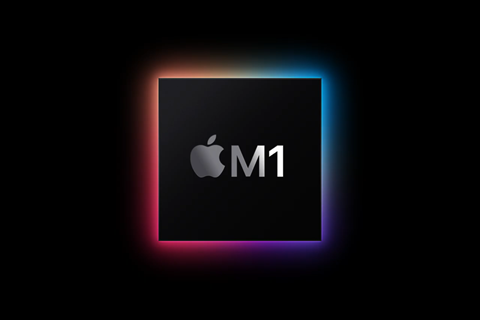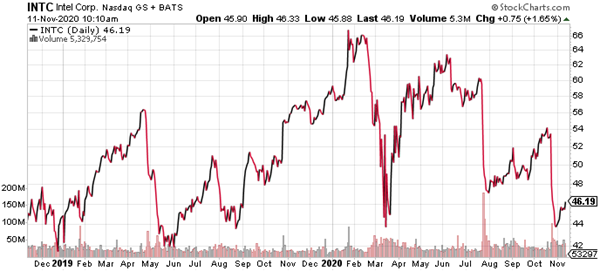New Apple Chips Could Send Intel into Oblivion
Shots were fired in the high stakes world of microprocessors yesterday, and the news is really bad for Intel Corp. (Nasdaq: INTC, Rated “C”), the world’s largest maker of those chips.
Apple Inc. (Nasdaq: AAPL, Rated “B”) managers, during an afternoon presentation, introduced M1, the first desktop processor designed in house. If corporate claims pan out, it is a watershed achievement in both performance and efficiency.
Far more significant is the fact that M1 will mark the beginning of the end for companies like Intel.
Most of the world’s computers run on Intel architecture. Its x86 silicon powers supercomputers, data centers, workstations and personal computers of all sorts. For many of those applications, Intel is still the leading supplier of chips. It’s a good business that has spawned a large ecosystem of suppliers and software developers.
In June, Apple promised to begin developing its own chips for Macs. The Cupertino, Calif.-based company could have stuck with the x86 architecture, but managers chose a different route. New Macs, they said, would bring a quantum leap in processing power and efficiency. They would also run software applications native to iPhones and iPads.
The M1 is built on the same ARM Holdings platform that powers those mobile devices, with one important design change. Intel-based Macs have separate chips for central processing unit, input/out control, security and memory. With M1, Apple chip designers decided to bring all of those functions onto a single chip, leading to tighter integration and power efficiency.
These “system on chip” designs are not new. Apple’s proprietary SoCs have long been the standard in mobile chip design. The company’s design prowess is the reason iPhones perform much better in benchmarks than competitor SoCs from QUALCOMM Inc. (Nasdaq: QCOM, Rated “B-”) and Samsung.
Related Post: Intel’s Surprise Advance May Be a Mirage
The quantum leap with M1 is that it’s not really a mobile chip. While it sips power like the processors in iPhones, it is also a powerhouse built from the ground up to deliver processing performance far beyond x86 designs.
M1 is the first SoC built on the five nanometer process. It has 16 billion transistors with an eight core CPU split between high performance and high efficiency. It also has an eight core graphics processing unit. This 16 core design is capable of processing a mind-blowing 11 trillion operations per second.

Specifications aside, the real advantage of custom silicon is that software can be tailored to emphasize strengths. Paired with Big Sur, the latest iteration of the Mac operating system, Apple managers claim spectacular performance over company hardware running Intel chips.
Inside the new MacBook Air, the low-end Apple laptop, M1 is able to deliver CPU speeds 3.5 times faster than the previous generation. Graphics are five times faster thanks to the integrated GPU. Better yet, the new Air gets 18 hours of battery life, six hours more than its x86 counterpart.
The M1 powers the flagship MacBook Pro to 2.8 times faster CPU speeds. The GPU renders graphics 5 times better. And battery life more than doubles to 20 hours.
There is one final kill shot for the x86 ecosystem.
The SoC design means makers of I/O, memory and security chips are no longer needed. This is reflected in the pricing for new Apple computers. Despite being more efficient in both power and battery life, neither the Air or Pro got a price increase over their predecessors.
Related Post: U.S. Attack on Chinese Tech Imperils American Chipmakers
That’s a big problem for Intel. It means less margin wiggle room. And the better performance means Apple competitors are likely to turn to ARM-based chips, too.
It could not come at a worse time for Intel. In September, NVIDIA Corp. (Nasdaq: NVDA, Rated “B-”), a key competitor, announced talks to acquire ARM. Analysts speculate NVIDIA managers will bring ARM architecture to the data center market.
Intel shares trade at 10 times forward earnings and 2.4 times sales. While these metrics might seem reasonable, the company is caught in a war it can’t win. And the Apple transition to ARM is only the beginning.
My 12-month price target for Intel is $51.20, representing a gain of 13% from current levels. Investors should use strength to close positions.
Best wishes,
Jon D. Markman




